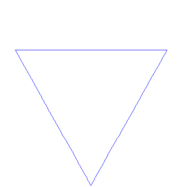| Line 40: | Line 40: | ||
Although fractals seem very complex with infinitely small details, they can often be created with very few lines of code on a computer. This is because they have simple and recursive definitions to create fractals. Recalling recursive form when working with series, recursive means that you are repeatedly applying the same rule, or definition. For example, the Mandelbrot set is defined is created by using the recursive definition, z<sub>n+1</sub> = z<sub>n</sub><sup>2</sup> + c. | Although fractals seem very complex with infinitely small details, they can often be created with very few lines of code on a computer. This is because they have simple and recursive definitions to create fractals. Recalling recursive form when working with series, recursive means that you are repeatedly applying the same rule, or definition. For example, the Mandelbrot set is defined is created by using the recursive definition, z<sub>n+1</sub> = z<sub>n</sub><sup>2</sup> + c. | ||
| − | ==== <small>Fractal dimension</small> | + | ==== <small>Fractal dimension</small> ==== |
| + | |||
| + | Here is a great video to understand fractal dimension and how it can be calculated:[https://www.youtube.com/watch?v=gB9n2gHsHN4 Fractal Dimension Explanation].<br /> | ||
---- | ---- | ||
Revision as of 21:22, 5 December 2020
Contents
Fractals
| Table of Contents |
|---|
| 1. Introduction |
| 2. Definition and Characteristics |
| 3. Generating Fractals |
| 4. Examples |
| 5. Applications |
1. Introduction
2. Definition and Characteristics
The most commonly used description for fractals is one that Benoit B. Mandelbrot published in his book, The Fractal Geometry of Nature. He says that a fractal is "a rough or fragmented geometric shape that can be split into parts, each of which is (at least approximately) a reduced-size copy of the whole." Additionally, Mandelbrot is the mathematician who coined the term "fractal" in 1975, and it is derived from the Latin words fractus which means fragmented or broken. Mathematicians do not agree on a single definition, and some mathematicians are against having a strict definition. However, they do agree that there are characteristics common in most fractals that could be used to describe the concept of fractals:
Self-Similarity
If a shape has self-similarity, it means that the whole has exact or approximately the same shape as a smaller part of itself. For example, broccoli is made up of smaller parts that have a similar shape to the whole, and those smaller parts have even smaller parts that have a similar shape. However, you will also notice that the smaller parts of broccoli are not exact copies of the whole broccoli. There are different types of self-similarity and many of them describe cases where the copies are not identical.
- Exact self-similarity: The whole and the smaller parts are identical. An example is the Koch Snowflake.
- Quasi self-similarity: This means that the shapes are similar but slightly different in some way. In other words, the broccoli would be an example of Quasi self-similarity. Another example in mathematics would be the Mandelbrot set.
- Statistical self-similarity: If something has statistical self-similarity, the shape might not necessarily be similar, but the statistical properties of the smaller part are similar to that of the whole. This is the case with most things in the real world with self-similarity.
- Multifractal scaling: this is when the fractal or geometry can be characterized by more than one [[Walther_MA271_Fall2020_topic17#Fractal Dimension|fractal dimension] (mentioned later).
Infinitely Detailed
Fractals are infinitely detailed, or in other words, they have infinitely small details. Even if you zoom continuously zoom into a fractal, you will still see smaller and smaller details. In turn, some fractals have emergent properties. A simple way of saying this is that the whole is greater than the sum of its parts. In the context of fractals, this means that the whole fractal might have properties that are independent of the incredibly small detailed parts.
Video of zooming into a fractal
Irregularity
Fractals have irregularities when zoomed in at any scale that make it extremely difficult to be described by Euclidean geometry.
Simple and Recursive Definition
Although fractals seem very complex with infinitely small details, they can often be created with very few lines of code on a computer. This is because they have simple and recursive definitions to create fractals. Recalling recursive form when working with series, recursive means that you are repeatedly applying the same rule, or definition. For example, the Mandelbrot set is defined is created by using the recursive definition, zn+1 = zn2 + c.
Fractal dimension
Here is a great video to understand fractal dimension and how it can be calculated:Fractal Dimension Explanation.


